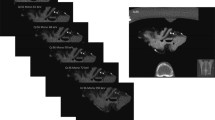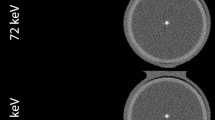Abstract
Our goal is to assess the ability of physicians to detect coronary calcifications in dual energy chest X-rays processed by a previously developed advanced algorithm. Because the chest X-ray is the most common imaging procedure, because the presence of coronary calcium provides proof of coronary artery disease, and because adherence to therapy can improve health, successful detection could positively impact healthcare for a large number of patients. Both dual energy chest and corroborative CT calcium score images were acquired. Dual energy images were processed with the advanced techniques, including sliding organ registration, so as to enhance coronary calcifications in two-shot dual energy acquisitions. We performed ROC to determine physicians’ ability to detect coronary calcifications. Since detection might be easier with heavier calcifications, we used various Agatston score cut-points for determining cases actually positive with calcification in the ROC analysis. In many cases, coronary calcifications were made more visible with the advanced processing as compared to conventional processing. At an Agatston cut-point of 300, coronary calcifications were detected with AUC = 0.85. There were marginal effects on detection performance found with increased X-ray exposure, nearby Agatston cut-point values, and coronary artery territory. Coronary calcifications can be detected in dual energy chest X-rays. The ability to detect disease compares very favorably to other accepted screening methods (e.g., X-ray mammography). As the chest X-ray is an already ordered procedure, there is an opportunity to detect a very large number of persons with coronary artery disease at zero or low cost.






Similar content being viewed by others
Data availability
Data are owned by the University Hospitals of Cleveland under a grant from GE Healthcare. Data are not publically available.
Code availability
CorCalDx-viz software was developed in house. It is not publically available.
References
Wen D, Nye K, Zhou B et al (2018) Enhanced coronary calcium visualization and detection from dual energy chest X-rays with sliding organ registration. Comput Med Imaging Graph 64:12–21. https://doi.org/10.1016/j.compmedimag.2018.01.004
Zhou B, Wen D, Nye K et al (2017) Detection and quantification of coronary calcium from dual energy chest X-rays: Phantom feasibility study. Med Phys 44:5106–5119. https://doi.org/10.1002/mp.12474
Mafi JN, Fei B, Roble S et al (2012) Assessment of coronary artery calcium using dual-energy subtraction digital radiography. J Digit Imaging 25:129–136. https://doi.org/10.1007/s10278-011-9385-y
Cardiovascular Disease Costs Will Exceed $1 Trillion by 2035, Warns the American Heart Association | American Heart Association. Available at https://newsroom.heart.org/news/cardiovascular-disease-costs-will-exceed-1-trillion-by-2035-warns-the-american-heart-association. Accessed 17 Feb 2017
(2017) Cardiovascular disease: a costly burden for America - Projections through 2035. Available at https://www.heart.org/idc/groups/heart-public/@wcm/@adv/documents/downloadable/ucm_491543.pdf. Accessed 27 Feb 2017
Budoff MJ, Gul KM (2008) Expert review on coronary calcium. Vasc Health Risk Manag 4:315–324
Greenland P, Bonow RO, Brundage BH et al (2007) ACCF/AHA 2007 clinical expert consensus document on coronary artery calcium scoring by computed tomography in global cardiovascular risk assessment and in evaluation of patients with chest pain: a report of the American College of Cardiology Foundation Clinical Expert Consensus Task Force (ACCF/AHA Writing Committee to Update the 2000 Expert Consensus Document on Electron Beam Computed Tomography) developed in collaboration with the Society of Atherosclerosis Imaging and Prevention and the Society of Cardiovascular Computed Tomography. J Am Coll Cardiol 49:378–402. https://doi.org/10.1016/j.jacc.2006.10.001
Hecht HS (2014) Coronary artery calcium scanning: the key to the primary prevention of coronary artery disease. Endocrinol Metab Clin North Am 43:893–911. https://doi.org/10.1016/j.ecl.2014.08.007
Blaha MJ, Yeboah J, Al Rifai M et al (2016) Providing evidence for subclinical CVD in risk assessment. Global Heart 11:275–285
Pugliese G, Iacobini C, Fantauzzi CB, Menini S (2015) The dark and bright side of atherosclerotic calcification. Atherosclerosis 238:220–230. https://doi.org/10.1016/j.atherosclerosis.2014.12.011
Martin SS, Blaha MJ, Blankstein R et al (2014) Dyslipidemia, coronary artery calcium, and incident atherosclerotic cardiovascular disease. Circulation 129:77–86. https://doi.org/10.1161/CIRCULATIONAHA.113.003625
Grundy SM, Stone NJ, Bailey AL et al (2019) 2018 AHA/ACC/AACVPR/AAPA/ABC/ACPM/ADA/AGS/APhA/ASPC/NLA/PCNA guideline on the management of blood cholesterol: a report of the American College of Cardiology/American Heart Association Task Force on Clinical Practice Guidelines. Circulation 139:e1082–e1143. https://doi.org/10.1161/CIR.0000000000000625
Gilkeson RC, Sachs PB (2006) Dual energy subtraction digital radiography: technical considerations, clinical applications, and imaging pitfalls. J Thorac Imaging 21:303–313. https://doi.org/10.1097/01.rti.0000213646.34417.be
Chen X, Gilkeson RC, Fei B (2007) Automatic 3D-to-2D registration for CT and dual-energy digital radiography for calcification detection. Med Phys 34:4934. https://doi.org/10.1118/1.2805994
Hillis SL (2007) A comparison of denominator degrees of freedom methods for multiple observer ROC analysis. Stat Med 26:596–619. https://doi.org/10.1002/sim.2532
Hillis SL, Berbaum KS, Metz CE (2008) Recent developments in the Dorfman-Berbaum-Metz procedure for multireader ROC study analysis. Acad Radiol 15:647–661. https://doi.org/10.1016/j.acra.2007.12.015
Yeboah J, Young R, McClelland RL et al (2016) Utility of nontraditional risk markers in atherosclerotic cardiovascular disease risk assessment. J Am Coll Cardiol 67:139–147. https://doi.org/10.1016/j.jacc.2015.10.058
Kelly KM, Dean J, Lee S-J, Comulada WS (2010) Breast cancer detection: radiologists’ performance using mammography with and without automated whole-breast ultrasound. Eur Radiol 20:2557–2564. https://doi.org/10.1007/s00330-010-1844-1
Berg WA, Zhang Z, Lehrer D et al (2012) Detection of breast cancer with addition of annual screening ultrasound or a single screening MRI to mammography in women with elevated breast cancer risk. JAMA 307:1394–1404. https://doi.org/10.1001/jama.2012.388
Gennaro G, Toledano A, di Maggio C et al (2010) Digital breast tomosynthesis versus digital mammography: a clinical performance study. Eur Radiol 20:1545–1553. https://doi.org/10.1007/s00330-009-1699-5
Pisano ED, Hendrick RE, Yaffe MJ et al (2008) Diagnostic accuracy of digital versus film mammography: exploratory analysis of selected population subgroups in DMIST. Radiology 246:376–383. https://doi.org/10.1148/radiol.2461070200
de Hoop B, Schaefer-Prokop C, Gietema HA et al (2010) Screening for lung cancer with digital chest radiography: sensitivity and number of secondary work-up CT examinations 1. Radiology 255:629–637
Awai K, Murao K, Ozawa A et al (2004) Pulmonary nodules at chest CT: effect of computer-aided diagnosis on radiologists’ detection performance. Radiology 230:347–352. https://doi.org/10.1148/radiol.2302030049
Evidence Summary: False-Positive and False-Negative Rates of Digital Mammography Screening: Breast Cancer: Screening - US Preventive Services Task Force. Available at https://www.uspreventiveservicestaskforce.org/Page/Document/evidence-summary-false-positive-and-false-negative-rates-of-/breast-cancer-screening1. Accessed 18 Dec 2018
Sabol JM, Liu R, Saunders R et al (2006) The impact of cardiac gating on the detection of coronary calcifications in dual-energy chest radiography: a phantom study. In: Raj S (ed) Medical Imaging 2006: Physics of Medical Imaging. International Society for Optics and Photonics, Bellingham
Souza AS, Bream PR, Elliott LP (1978) Chest film detection of coronary artery calcification. the value of the CAC triangle. Radiology 129:7–10. https://doi.org/10.1148/129.1.7
Acknowledgements
This project was supported by the Case-Coulter Translational Research Partnership (PY15-P410), by the National Heart Lung and Blood Institute under award number R01 HL143484 and by a sponsored research award from General Electric Healthcare. This research is a collaboration between Case Western Reserve University and University Hospitals of Cleveland, Cleveland Medical Center. Special thanks go out to the team at University Hospitals of Cleveland who collected the images used in this work. We thank Katelyn Nye and John Sabol of GE Healthcare for their support on this project. The veracity guarantor, Hao Wu, affirms that to the best of his knowledge that all aspects of this paper are accurate. Software described herein was developed for investigational use. It is not available for clinical usage, nor is it FDA approved.
Funding
This project was supported by the Case-Coulter Translational Research Partnership (PY15-P410) and by a sponsored research award from General Electric Healthcare.
Author information
Authors and Affiliations
Corresponding author
Ethics declarations
Conflict of interest
The authors declares that they have no conflict of interest.
Additional information
Publisher's Note
Springer Nature remains neutral with regard to jurisdictional claims in published maps and institutional affiliations.
Rights and permissions
About this article
Cite this article
Song, Y., Wu, H., Wen, D. et al. Detection of coronary calcifications with dual energy chest X-rays: clinical evaluation. Int J Cardiovasc Imaging 37, 767–774 (2021). https://doi.org/10.1007/s10554-020-02072-4
Received:
Accepted:
Published:
Issue Date:
DOI: https://doi.org/10.1007/s10554-020-02072-4




